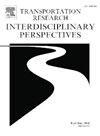Transportation finance equity: A theoretical and empirical review of pricing equity, expenditure equity, and pricing-expenditure equity in US transit provision
IF 3.8
Q2 TRANSPORTATION
Transportation Research Interdisciplinary Perspectives
Pub Date : 2025-05-01
DOI:10.1016/j.trip.2025.101418
引用次数: 0
Abstract
Research concerning transit pricing and expenditure equity overwhelmingly emphasizes pricing disparities or expenditure disparities without consideration of the other. Findings broadly indicate that transit investments and fare policies in the United States disproportionately burden marginalized populations or disproportionately benefit socioeconomically advantaged populations. However, disparities in what different populations pay relative to the costs of services they receive—that is, the economic subsidies they receive—are surprisingly underexplored in the literature. Yet, this analysis is essential for evaluating whether government subsidies are being used effectively, efficiently, and equitably. In addition, by overlooking how costs and benefits vary across locations and times of travel, the literature often treats the amount people travel as fully reflective of both the benefits they receive and the costs they impose. Finally, the diversity of transit modes represented in the literature is imbalanced. Rail transit is disproportionately represented in capital-focused research, while bus transit is disproportionately represented in operations-focused research. The literature could benefit from a broader application of transit modes, more spatially and temporally granular cost allocation models, and the use of cost recovery (or subsidy) disparity as a measurement of equity.
交通融资公平:对美国运输供应中定价公平、支出公平和定价-支出公平的理论和实证回顾
关于过境定价和支出公平的研究绝大多数强调定价差异或支出差异,而不考虑其他差异。研究结果广泛表明,美国的交通投资和票价政策不成比例地加重了边缘化人群的负担,或不成比例地使社会经济优势人群受益。然而,不同人群支付的费用与他们获得的服务成本(即他们获得的经济补贴)之间的差异,在文献中却出人意料地没有得到充分的探讨。然而,这种分析对于评估政府补贴是否得到有效、高效和公平的使用至关重要。此外,由于忽视了成本和收益在旅行地点和时间上的差异,文献通常认为人们的旅行数量充分反映了他们所获得的收益和所造成的成本。最后,文献中所代表的运输方式的多样性是不平衡的。轨道交通在以资本为重点的研究中所占比例过高,而公共汽车在以运营为重点的研究中所占比例过高。文献可以受益于更广泛的交通方式的应用,更多的空间和时间粒度的成本分配模型,以及使用成本回收(或补贴)差距作为公平的衡量标准。
本文章由计算机程序翻译,如有差异,请以英文原文为准。
求助全文
约1分钟内获得全文
求助全文
来源期刊

Transportation Research Interdisciplinary Perspectives
Engineering-Automotive Engineering
CiteScore
12.90
自引率
0.00%
发文量
185
审稿时长
22 weeks
 求助内容:
求助内容: 应助结果提醒方式:
应助结果提醒方式:


